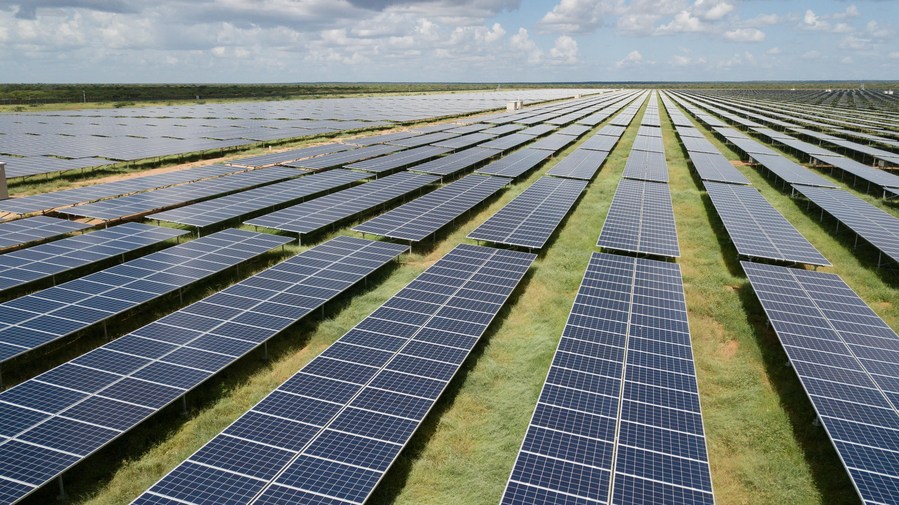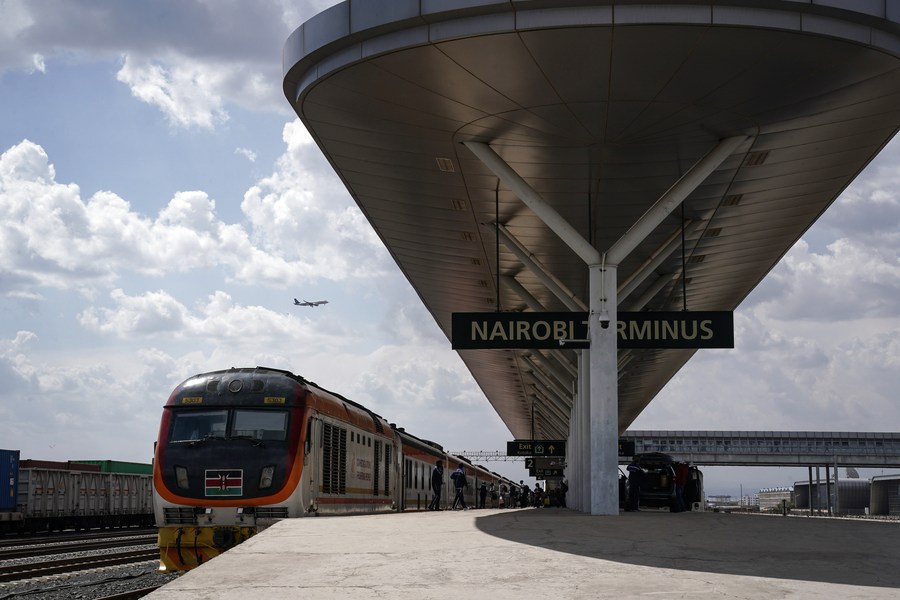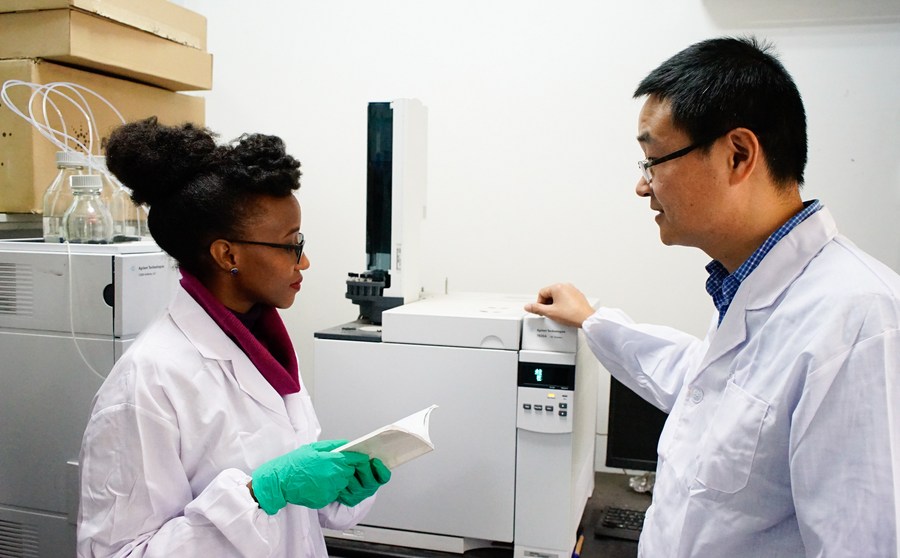
An aerial photo taken on December 13, 2019 shows a 50 MW solar power farm in Garissa, Kenya. Designed and built by EPC contractor China Jiangxi Corporation for International Economic and Technical Co-operation (CJIC) in partnership with Kenya’s Rural Energy Authority (REA), the plant is one of Africa’s largest photovoltaic power plants. (Xinhua/Chi Han)
„Without the BRI, many of the development gains enjoyed by Kenya and other African countries would not have been possible, at least not in the relatively short term,” said one African expert.
Xinhua writers Daniel Ogo, Li Hualing
Nairobi, Oct. 29 (Xinhua) — The lives of Kenyans have improved following the successful implementation of China’s proposed Belt and Road Initiative (BRI).
Tens of thousands of Chinese investors have set foot in Kenya.
Experts agree that the BRI has accelerated the adoption of Chinese technology to address local challenges in Kenya and many other African countries.
infrastructure
In the decade since the BRI was launched, Chinese companies have built ports and railways and upgraded airports in Kenya, promoting business due to growing industrial demand.
Peter Kagwanja, CEO of the Africa Policy Institute, a regional think tank on China-Africa relations, said Kenya’s business and service sectors are quickly benefiting from improved infrastructure.
Tourists traveling between the capital city of Nairobi and Kenya’s coastal city of Mombasa have found the Standard Gauge Railway (SGR) convenient and affordable. According to the Kenya Railways Corporation, more than 10 million passengers have used the „Madaraga Express” trains since their launch in 2017, with annual usage set to hit a new peak of nearly 3 million passengers in 2023.
Similarly, the SGR freight train has become the preferred choice for businesses looking to move their cargo further inland and across borders from the Port of Mombasa.
According to the Kenya Railways Corporation, SGR trains have hauled 26 million tonnes of cargo since service began in 2018.
Sep. 20, 2023 photo shows a train bound for Mombasa waiting at the Nairobi terminus station in China on the Mombasa-Nairobi Standard Gauge Railway (SGR) built in Nairobi, Kenya. (Xinhua/Han Xu)
„A project like the SGR has ensured that the link between peace and development is established and sustained,” Kakwanja said. „BRI infrastructure development connects not only Kenya but its neighbors and the Horn of Africa, facilitating trade, cultural exchange and development.”
The Nairobi Expressway, a four-lane highway designed and implemented by Chinese contractors in downtown Nairobi, has eased traffic congestion on Kenya’s northern corridor, a major route for people and exports.
The 27-km expressway has reduced travel time across the city from two hours to 20 minutes, with more than 20 million vehicles using the route in a year, according to MOJA Expressway, the company that operates the toll road.
The Kenyan government is seeking to ease the infrastructure deficit in the country, and this project is a prime example of the public-private infrastructure model.
Another beneficiary of the initiative is David Maina Kamor, a young Kenyan. After years of professional study in China, Kamor returned to Kenya in 2014. He soon joined China Aerospace Construction Group Co., Ltd., where he worked as a transmission engineer. Kamor said he is part of a team currently carrying out the Kenya Power Transmission Expansion Project, which aims to expand access to reliable electricity supply to previously underserved areas.
„Without the BRI, many of the development benefits enjoyed by Kenya and other African countries would not have been possible, at least in the relatively short term,” said Karani Muthamiah, founder and director of China. Africa Contact Centre.
There is a massive exchange of knowledge and skills between Chinese and local experts in Kenya. „China has introduced modern technology in all sectors, cheaper ways to execute development projects and, importantly, a very short time to execute monumental projects,” Muthamiya said.
Digital economy
Improved digital infrastructure has ushered in a new growth phase in Kenya’s economy — internet connectivity is more efficient; Businesses are supported with modern telecommunication technology systems; Administration has moved to electronic platforms; And local and international consumers can buy and sell goods online.
Working with Chinese technology giant Huawei, Kenya’s largest mobile telecommunications operator, Safaricom, has developed and launched an innovative mobile money transfer system.
Chinese companies are also helping Kenya develop Konza Technopolis, a technology city in Machakos County, about 60km south of the capital Nairobi.
The installation of high-speed internet infrastructure and the provision of high-end smart devices by Chinese companies have made it possible for Kenyans to engage and do business within the country and across borders.
„The BRI has helped accelerate Kenya’s development by going to the fundamentals of economic architecture,” Abukar Arman, a former Somali diplomat, geopolitical analyst and author of the book Broken Camel Bells, told Xinhua.
„No country can develop its trade, attract investors and truly develop its economy without some critical infrastructure. China has built not only IT infrastructure but also railways, paved roads, ports, hospitals, schools and electricity grids across Africa,” Arman said.
A researcher from the China-Africa Collaborative Research Center affiliated with the Chinese Academy of Sciences (CAS) teaches Kenya Theresia Mungai using an experimental instrument at CAS’s Wuhan Botanical Garden in Wuhan, central China’s Hubei province, March 21, 2017. (Xinhua/Kong Jing)
Agriculture
China has actively supported African countries in agriculture to increase productivity and build stronger defenses against food insecurity.
In Kenya, the agricultural industry, which is the main driver of growth, employs 65-70 percent of the labor force and typically accounts for 30 percent of GDP, according to the World Bank.
China has supported the modernization of Kenya’s agricultural sector through frequent exchanges of knowledge and technology between the two countries’ agricultural enterprises.
Chinese companies have developed linkages with research centers in Kenya on breeding high-yielding seed varieties and preventing diseases. Also, many Kenyan students have gone to China to study agriculture at various universities.
Originating from the arid loess plateau of China, the double-furrow seeding agricultural technology in all images has now been applied to agricultural production in Kenya based on local conditions to alleviate the impact of severe drought on food production.
The China-Africa Joint Research Center is hosted at the Jomo Kenyatta University of Agriculture and Technology, Kenya. Here, China has helped Kenya develop exceptional skills in areas such as biodiversity conservation, precision agriculture and climate mitigation.
In November 2022, researchers from the two countries jointly identified ways to increase the productivity of a local maize variety grown in arid regions by 50 percent.
The University’s Vice-Chancellor Victoria Ngumi recently noted that new maize production technology at the Collaborative Research Center could further improve Kenya’s food security while protecting the environment. ■

. „Gracz. Namiętny pionier w mediach społecznościowych. Wielokrotnie nagradzany miłośnik muzyki. Rozrabiacz”.


